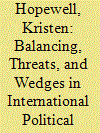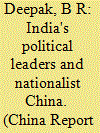|
|
|
Sort Order |
|
|
|
Items / Page
|
|
|
|
|
|
|
| Srl | Item |
| 1 |
ID:
192097


|
|
|
|
|
| Summary/Abstract |
Despite considerable tensions, China and India formed a surprising alliance at the WTO. Their alliance proved highly successful, bringing an end to American dominance and sharply curtailing the ability of the US to set the rules of global trade. However, the article shows, a key risk of soft balancing within an international institution is that, if successful, it may cause the dominant power to abandon the institution altogether. The US responded to China and India’s soft balancing by turning away from the WTO, actively undermining its rules and enforcement mechanism, and pursuing its interests through bilateral channels. The article thus identifies a distinct and previously unrecognized wedge strategy—vertical forum-shifting, or moving the action from international institutions to bilateral negotiations, to split an adversary coalition.
|
|
|
|
|
|
|
|
|
|
|
|
|
|
|
|
| 2 |
ID:
133738


|
|
|
|
|
| Publication |
2014.
|
| Summary/Abstract |
This article discusses how, owing to the commonalities in thoughts and actions of Indian and Chinese nationalists, they forged close ties not only at the individual, but also at the organizational, levels. It posits that while the early Indian nationalists sought to pursue the path of armed struggle to dislodge the British from India, in the second phase leaders of the Indian National Congress (INC) sought to establish links with the Kuomintang (KMT), the ruling party in China. The Indian leadership, especially Nehru, was of the view that there was much in common in the struggle carried out in different colonial countries, including the unification drive in China in the 1920s, and that therefore there was a need to forge close ties to support each other's struggles. It was this thinking of Nehru and others national leaders including Gandhi that culminated in Nehru's China visit in 1939 and Chiang Kai-shek's India visit in 1942, although Chiang's prime objective was to muster India's support for the Allied war effort. The quest for alliance with China did not die out even after the Chinese Revolution; however, developments that unfolded thereafter led in a different direction.
|
|
|
|
|
|
|
|
|
|
|
|
|
|
|
|
|
|
|
|
|